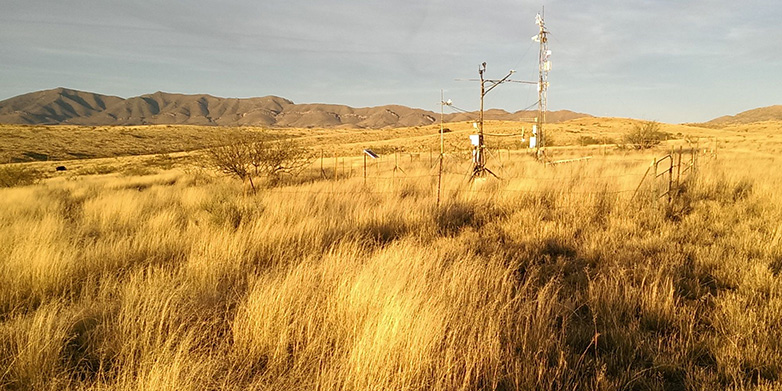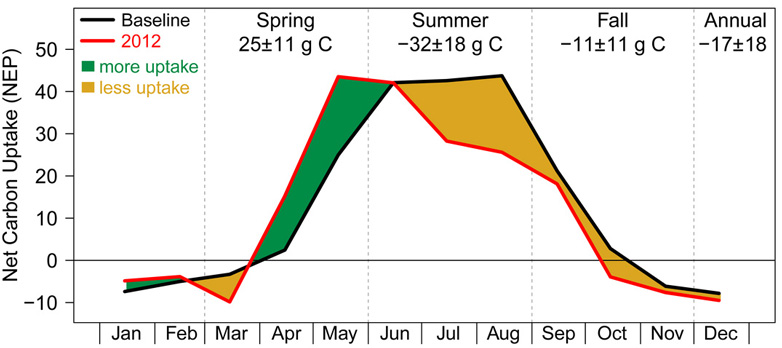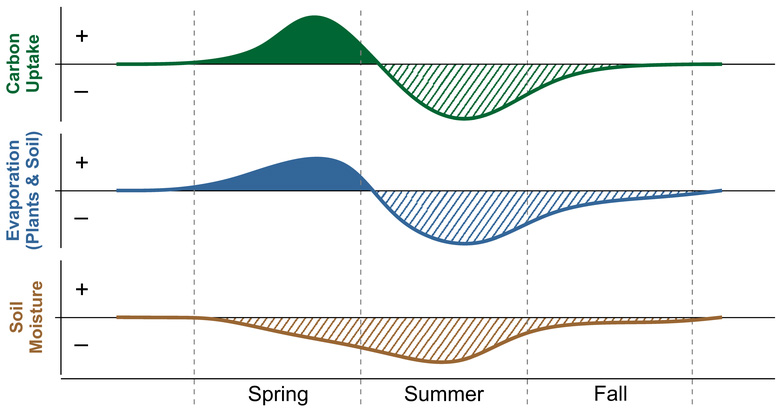The United States absorbed carbon dioxide despite a drought
Researchers have shown that the warm spring of 2012 in the US caused plants to absorb more carbon, thereby compensating for reductions during the subsequent summer drought.

In the US, spring 2012 was the warmest on record. The subsequent summer was dryer and hotter than any summer since the 1930s, a period that became known in the history books as the ‘Dust Bowl’. In 2012, drought and heat afflicted almost the entire contiguous United States.
Climate researchers suspected that this summer drought four years ago could turn the contiguous United States into a carbon source, as was the case in Europe during the hot summer of 2003. During a normal year, ecosystems take up more carbon from the air than they release. They therefore act as a carbon sink – an effect that plays an important role for the world’s climate. This is because plants take up carbon dioxide (CO2) for growth during photosynthesis and then store it in the form of biomass and in the soil. Through this mechanism, ecosystems compensate for a third of the anthropogenic CO2 emissions.
A team of researchers from the US, Australia, the Netherlands and ETH Zurich have now shown that the contiguous United States remained a carbon sink in 2012, despite the drought. The study has just been published in the journal PNAS.
The researchers found that the warm spring caused trees, grasses and crops to start growing earlier in the year. The ecosystems thus absorpted more carbon from the air than during a «normal» spring.
However, during the subsequent drought, the ecosystems absorbed less carbon than usual, as the plants reduced growth due to the dry and hot conditions. Nevertheless, the overall carbon balance remained positive. “The increase in carbon uptake during the warm spring compensated for the reductions in uptake during the drought,” says ETH researcher Sebastian Wolf, who led the study.
Grasslands release CO2 during drought
Across the entire contiguous United States, the extensive forests of the Appalachians were a particularly effective carbon sink. These forests absorbed additional carbon during spring, and remained largely unaffected by drought during the summer months. On the other hand, the grasslands of the Midwest also absorbed more carbon during the warm spring but their uptake was substantially reduced during the summer drought, as the vegetation became senescent.

In addition, the scientists found indications that the drought and heat in summer 2012 in the US were probably intensified by a feedback mechanism from the warm spring: as the plants started growing earlier, they also depleted their soil water resources earlier in the year. The ecosystems were thus more susceptible to the drought in summer. And due to the water limitations, plants were forced to close their stomata sooner.
As long as plants have sufficient water, they keep the stomata on their leaves open to exchange CO2, water vapour and oxygen with the atmosphere. When water becomes scarce, they close their stomata and thus evaporate less water vapour. The missing effect of evaporative cooling then intensifies the heat and therefore the stress for the plants.
A unique combination of measured data
Wolf and his colleagues combined various sources of data for their analysis. The study incorporated measurements of environmental conditions from 22 locations across the US. The researchers used special towers to take continuous measurements for at least five years; these measurements included temperature, soil moisture, precipitation, and the exchange of carbon dioxide and water between the ecosystems and the atmosphere.
The scientists also used measurements from the satellite platform MODIS to determine the CO2 uptake of vegetation across the entire US. In addition, measurements of CO2 concentrations from tall towers with a height of up to 300 metres were combined with models in order to estimate the CO2 uptake from an atmospheric perspective.
Through a clever combination of these different datasets, the researchers were able to calculate the carbon exchange for the entire contiguous United States during 2012.
Reference
Wolf S, Keenan TF, Fisher JB, Baldocchi DD, Desai AR, Richardson AD, Scott RL, Law BE, Litvak ME, Brunsell NA, Peters W, van der Laan-Luijkx IT (2016) Warm spring reduced carbon cycle impact of the 2012 US summer drought. Proceedings of the National Academy of Sciences. DOI external page10.1073/pnas.1519620113call_made


